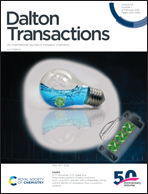A cancer cell-specific benzoxadiazole-based fluorescent probe for hydrogen sulfide detection in mitochondria†
Abstract
The present work describes the design and biological applications of a novel colorimetric and fluorescence turn-on probe for hydrosulfide detection. The probe was designed to introduce hemicyanine as the fluorescent skeleton and 7-nitro-1,2,3-benzoxadiazole as the recognition site. The optical properties and responses of the probe towards HS−, anions and some biothiols indicate an impressively high selectivity of the probe towards HS− such that it can be effectively used as an indicator for monitoring the level of HS− in living cells. In biological experiments using the probe, the H2S levels are found to be higher in cancer cells than in normal cells. In addition, the probe is shown to specifically and rapidly detect endogenous H2S, which is produced primarily in the mitochondria of cancer cells, as demonstrated by a co-localization experiment using specific trackers for the detection of cellular organelles in pharmacological inhibition or stimulation studies, without any significant cytotoxic effects. Thus, the results of the chemical and biological experiments described herein demonstrate the potential of this novel probe to specifically, safely, and rapidly detect H2S to distinguish cancer cells from normal cells by targeting it specifically in mitochondria.



 Please wait while we load your content...
Please wait while we load your content...